History and Research
Department of Archives and Records
Over 15,000 years ago, the Wisconsin glacier crept inexorably across northeastern Ohio’s Appalachian Plateau, shearing off and grinding down mountain tops, then depositing fine layers of topsoil and hills of glacial till, full of sandstone and granite pebbles. Massive ledges of Sharon Conglomerate were exposed to weathering and later used for the construction of buildings, roads, and bridges. With the retreat of the glacier, ancient Lake Maumee shrank to become today’s Lake Erie, leaving behind sand ridges for travel. These ridges developed from animal and Native American trails to the roads we know today as Johnny Cake Ridge, Middle Ridge, North Ridge, and Mentor/Euclid Avenue. During the glacial period, valleys were carved for the Grand Geauga, Cuyahoga, and Chagrin Rivers. All three of these major rivers rise today in Geauga County, flow south, then fishhook abruptly northward into Lake Erie.
 |
As the climate warmed, life returned to the lakeshore region. Hemlock and white pine trees grew on the hilltops, surrounded by valleys thick with maple, black walnut, chestnut, and oak. The heavy forest sheltered geese, elk, beaver, black bear, and timber wolves. Wild cats (which we know as raccoons) were so prevalent that the Native Americans named the rivers for the animal. The Grand Geauga River took it name from “Sheauga”, a Native American word for raccoon. Native Americans hunted game using the ridges and rivers as transportation networks. Archeological excavations have uncovered remains of the Whittlesey people. When the Whittleseys departed the lakeshore during the Iroquois annihilation of the Erie tribe in the 1650’s, Geauga became a part of the far-flung hunting territory claimed by the Iroquois. Through the 1740s European trade focused on the Cuyahoga River, so little evidence has been found of the Native American in Geauga. A pioneer reminiscence recounts a small Native American village on the Upper Cuyahoga near Burton and a chief so taken with a young girl named Limery Umberfield that he offered to purchase her for $1000. When his offer was refused, he threatened to steal her. | |
|
The death of Native American activity in Geauga proved a blessing for the Euro-American settlement. With no need to cluster near a fort for protection, pioneers confidently spread over the landscape after the first permanent settlement in Burton in 1798 and the second in Middlefield (then Batavia) in 1799. The sand ridges and rivers became highways for the westward New Englanders seeking land in the Connecticut/Ohio Western Reserve, of which Geauga was a part. Pioneers purchased land, then packed their belongings and dreams into wagons for the muddy, bumpy trek west. They followed the Lake Trail along the ridges of the ancient lakeshore or the Forbes Road through Pennsylvania, heading for a place described as a land of milk and honey in the 1803 Hartford Courant. Many were the families of Revolutionary War veterans. |
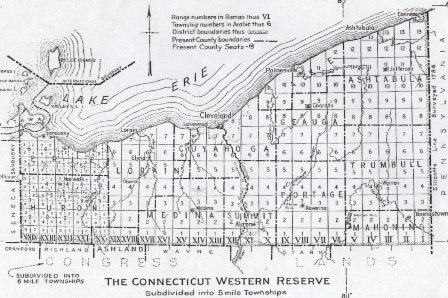 |
|
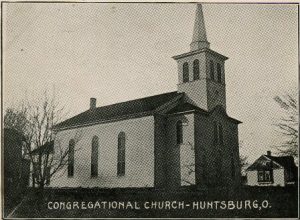 |
These pioneers brought with them New England culture and traditions that still appear in Geauga today. Numerous place names have matches in New England (Hambden for Hampden, Munson for Monson, Newbury for Newbury Port, Chester, Berkshire schools). These migrants were active in the Whig Party, then its descendent, today’s Republican Party. The white steeples of Protestant churches, especially Congregational, Methodist, and Baptist, towered over most town structures by the 1840s. Demonstrating the New England belief in sound education, most communities started schools early in their history. Burton founded the Erie Literary Society in 1803 and pressed the new state of Ohio for a college charter for their small community. Although the institution was not successful and the charter removed to Hudson, Ohio, it paved the way for the founding of the Western Reserve College in 1824, which became Case Western Reserve University of Cleveland. | |
| The sweetest tradition New Englanders brought to Geauga was maple syrup. This tradition is still active through independent syrup production, a permanent sugar camp operated by the Chamber of Commerce on Burton Square, and the annual Geauga County Maple Festival. The Maple Festival was founded in 1926 in an attempt to market Ohio syrup in competition with Vermont syrup. The Geauga County News announced that Chardon was “going to treat the general public to a good old fashioned maple sugar eat April 9 and 10.” The event featured free dishes of maple syrup, a sugar camp, tapped trees, an ox team gathering sap, and a maple products display. Festival planners expected 5,000 visitors and worried over the April ice storm. Over 15,000 people attended, and the festival has become an annual tradition. | 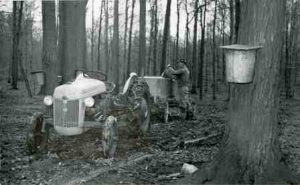 |
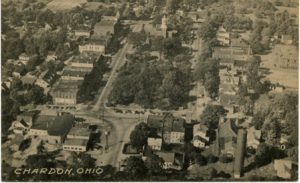 |
New England town planning is still apparent on the landscape. Geauga pioneers believed strongly in a central green surrounded by the community’s most valuable institutions-church, school, and government-and often supplemented by the homes of prominent families and primary commercial establishments. This pattern is preserved in the town squares of Chardon, Burton, and Thompson with variations in Parkman, Huntsburg, Claridon, and Chester. Both Chardon and Burton Square are listed on the National Register of Historic Places and are the center of numerous community gatherings. Small crossroads communities serving nearby agriculture communities were founded in other areas of the county. East Claridon grew along water and railway transportation networks, while Fowler’s Mill and Fullertown developed as millstream hamlets. | |
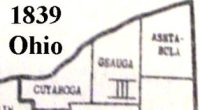 |
As the population grew, the Ohio General Assembly created the County of Geauga on December 31,1805. County business was initially conducted in New Market and Champion in northern Geauga. The site was controversial for its lack of population, being a wilderness, but was within one mile of Geauga’s geographic center. People from Painesville in northern Geauga and Burton in central Geauga fought for decades to the have the seat moved. The inability of the northern Geaugans to move the county seat closer to their population center in Painesville resulted in the controversial creation of Lake County in 1840 from northern Geaugan lands. | 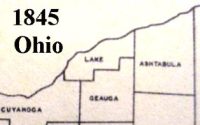 |
| Meanwhile, the Geauga County Commissioners purchased land for the county seat for $400.00 in 1824 for the courthouse from Boston entrepreneur Peter Chardon Brooks and the area was named Chardon. In 1812, Captain Edward Paine, Jr., county recorder and clerk of courts, constructed a log cabin on the square to serve as his family home and courthouse. As Geauga population and county grew, a clapboard courthouse had to be built in 1813. Two major events held in that courthouse in 1823 may have inspired County Commissioners to build a larger structure on Main Street the next year. In March 1823, Benjamin Wright, Jr. was convicted of murdering Zophar Warner. His sentence, to hang by the neck until dead, was carried out on the third Thursday in May. The Painesville Telegraph reported an attendance on Chardon Square of over 4,000 people, including a cavalry, rifle companies, fife and drum corps, out-of-county visitors, and Geaugans. | 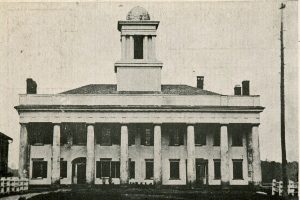 |
|
| Geaugans gathered on the square on October 23, 1823, for the first Geauga Cattle Fair and Show. Rail pens were constructed for livestock while smaller articles were exhibited in the courthouse. The Geauga County Agriculture and Manufacturing Society awarded thirteen premiums, six for feminine arts such as table linen and grass bonnets. In 1853, the society moved its fair to permanent grounds in Burton where it remains today as a Labor day weekend event. The Great Geauga County Fair is now Ohio’s oldest, continuously operating fair, having held an exhibition every year since 1823, in spite of date changes, drought, and even war. | 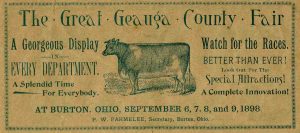 |
|
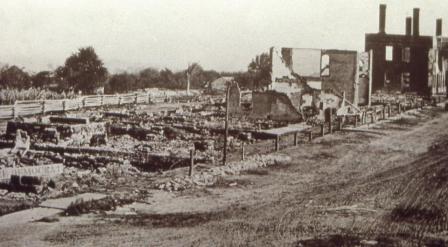 |
The 1824 Courthouse was destroyed in a devastating fire on Chardon’s Main Street in July 1868.The clapboard business blocks were rebuilt in its place-this time in brick-but the Courthouse was moved to the center of the green where it stands today. The High Victorian Italianate architecture of 1869 Courthouse is echoed in the Main Street Business Blocks, creating a harmony of design in the brick and stone structures. It is this courthouse and main street that are on the National Register of Historic Places. | 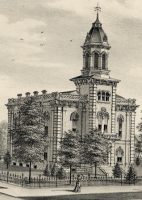 |
 |
Geauga’s population continued to grow and diversify. Amish families from Wayne and Holmes Counties migrated into eastern farmland beginning in the 1880’s. Czech-Slovak people from Cleveland Amish Residents moved into western Geauga in the 1890s and purchased 136 acres in 1925 for the small community of Taborville. African-Americans migrated from Georgia after World War I to work in a foundry near today’s Chagrin Falls Park Community. Clevelanders flocked to Geauga for recreation, then permanent homes. The hotels and water cure spa on Little Mountain attracted wealthy Clevelanders from the 1830s Little Mountain Resort into the 1920s. Thompson became well known for the recreational possibilities of its hotel near the Ledges, and became a park in 1941. When the Bass Lake House was abandoned in 1919, a lake community was founded that attracted artists, bankers, and newspapermen. Aquilla Village, also clustered around a lake, incorporated in 1946, as summer cottages became permanent homes. | 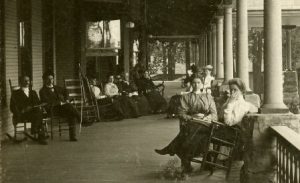 |
|
The extension of the Cleveland and Eastern Interurban into Geauga in 1900 spurred increased. Punderson Lake, now a state park, became a popular destination, as did the hotel and dance hall at Chester Caves. Today Six Flags traces its origin back to the Giles Picnic Grounds that became the Geauga Lake Amusement Park, established in 1884 near the Erie Railroad. Today, Geauga’s population tops 91,000 and spreads over a landscape varying from western suburban to eastern rural. A key issue is preservation of quality of life. Increasing green space is preserved through parkland and conservancy acquisitions as well as a Farmland Preservation program, new in 2001. Fourteen properties are listed on the National Register of Historic Places. Geauga’s beautiful landscape, abundant natural resources, and visual heritage still attract tourists as well as residents. |
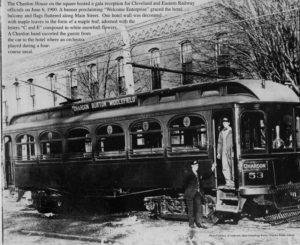 |
By Bari Oyler Stith, Ph.D, Copyright 2008
